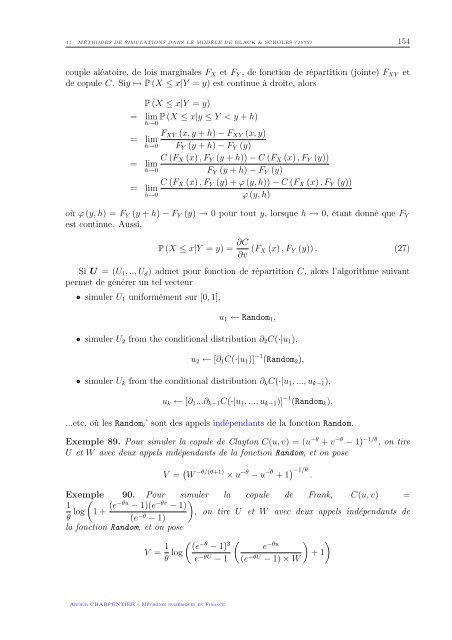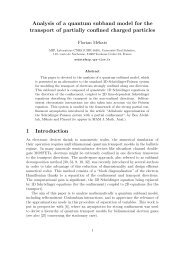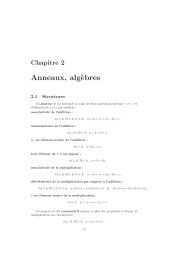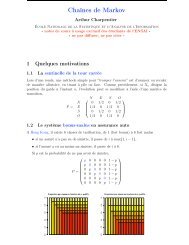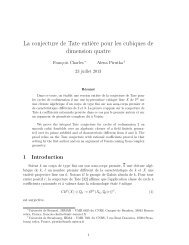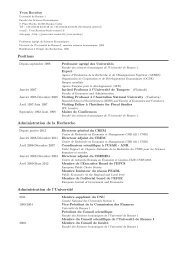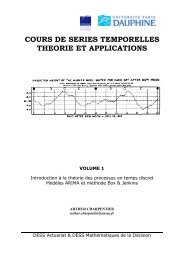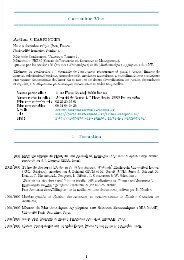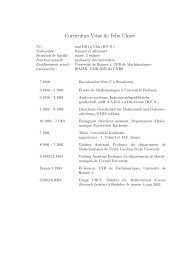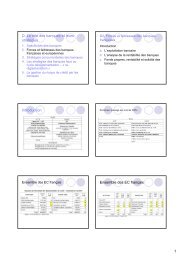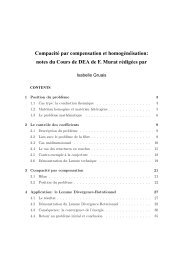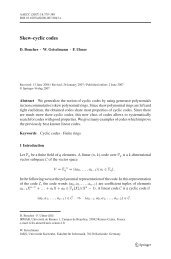Méthodes numériques en finance
Méthodes numériques en finance
Méthodes numériques en finance
Create successful ePaper yourself
Turn your PDF publications into a flip-book with our unique Google optimized e-Paper software.
11 MÉTHODES DE SIMULATIONS DANS LE MODÈLE DE BLACK & SCHOLES (1973) 154<br />
couple aléatoire, de lois marginales F X et F Y , de fonction de répartition (jointe) F XY<br />
de copule C. Siy ↦→ P (X ≤ x|Y = y) est continue à droite, alors<br />
et<br />
P (X ≤ x|Y = y)<br />
= lim<br />
h→0<br />
P (X ≤ x|y ≤ Y < y + h)<br />
= lim<br />
h→0<br />
F XY (x, y + h) − F XY (x, y)<br />
F Y (y + h) − F Y (y)<br />
C (F X (x) , F Y (y + h)) − C (F X (x) , F Y (y))<br />
= lim<br />
h→0 F Y (y + h) − F Y (y)<br />
C (F X (x) , F Y (y) + ϕ (y, h)) − C (F X (x) , F Y (y))<br />
= lim<br />
h→0 ϕ (y, h)<br />
où ϕ (y, h) = F Y (y + h) − F Y (y) → 0 pour tout y, lorsque h → 0, étant donné que F Y<br />
est continue. Aussi,<br />
P (X ≤ x|Y = y) = ∂C<br />
∂v (F X (x) , F Y (y)) . (27)<br />
Si U = (U 1 , .., U d ) admet pour fonction de répartition C, alors l’algorithme suivant<br />
permet de générer un tel vecteur<br />
• simuler U 1 uniformém<strong>en</strong>t sur [0, 1],<br />
u 1 ← Random 1 ,<br />
• simuler U 2 from the conditional distribution ∂ 2 C(·|u 1 ),<br />
u 2 ← [∂ 1 C(·|u 1 )] −1 (Random 2 ),<br />
• simuler U k from the conditional distribution ∂ k C(·|u 1 , ..., u k−1 ),<br />
u k ← [∂ 1 ...∂ k−1 C(·|u 1 , ..., u k−1 )] −1 (Random k ),<br />
...etc, où les Random i ’ sont des appels indép<strong>en</strong>dants de la fonction Random.<br />
Exemple 89. Pour simuler la copule de Clayton C(u, v) = (u −θ + v −θ − 1) −1/θ , on tire<br />
U et W avec deux appels indép<strong>en</strong>dants de la fonction Random, et on pose<br />
V = ( W −θ/(θ+1) × u −θ − u −θ + 1 ) −1/θ<br />
.<br />
Exemple<br />
(<br />
90. Pour simuler<br />
)<br />
la copule de Frank, C(u, v) =<br />
1<br />
θ log 1 + (e−θu − 1)(e −θv − 1)<br />
, on tire U et W avec deux appels indép<strong>en</strong>dants de<br />
(e −θ − 1)<br />
la fonction Random, et on pose<br />
V = 1 ( (<br />
) )<br />
(e −θ<br />
θ log − 1) 3 e −θu<br />
+ 1<br />
e −θU − 1 (e −θU − 1) × W<br />
Arthur CHARPENTIER - Méthodes numériques <strong>en</strong> Finance


